
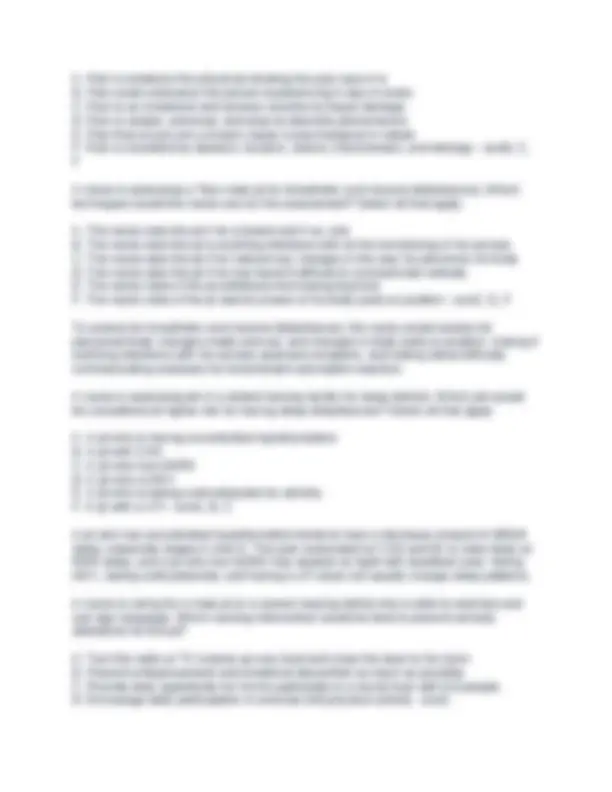
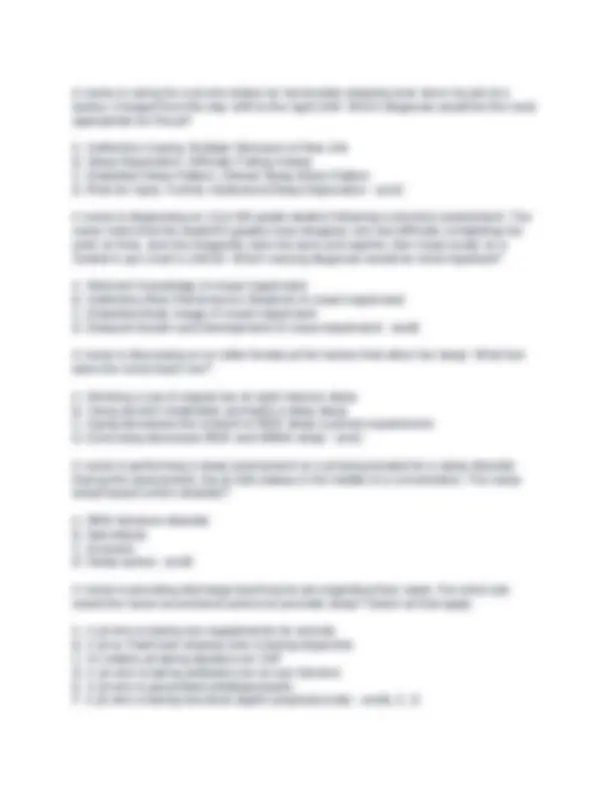
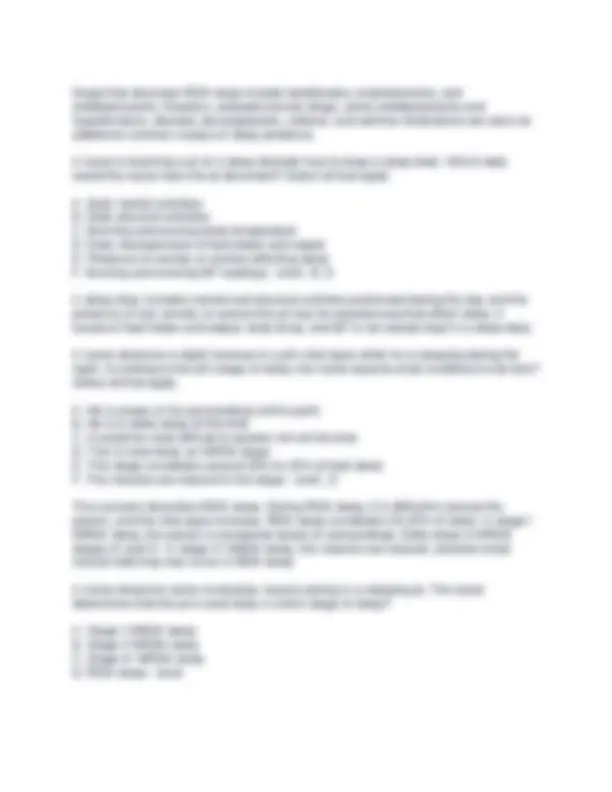
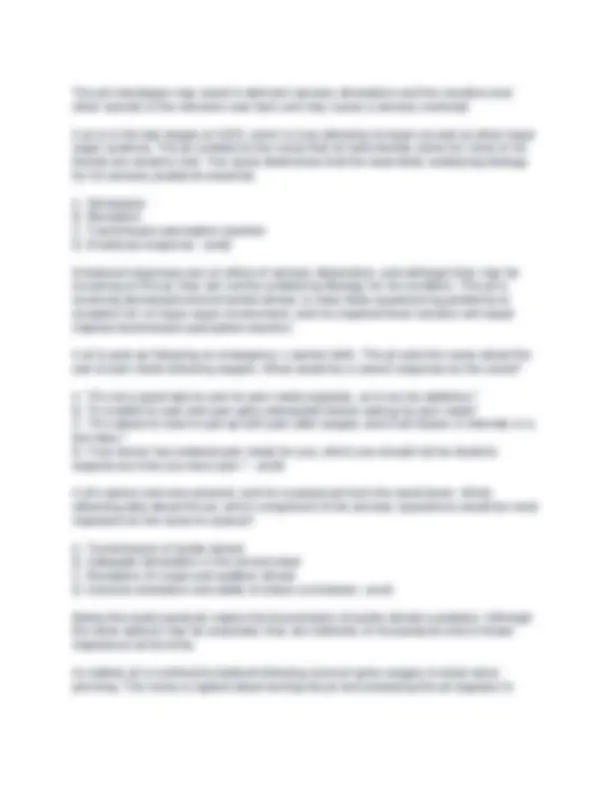
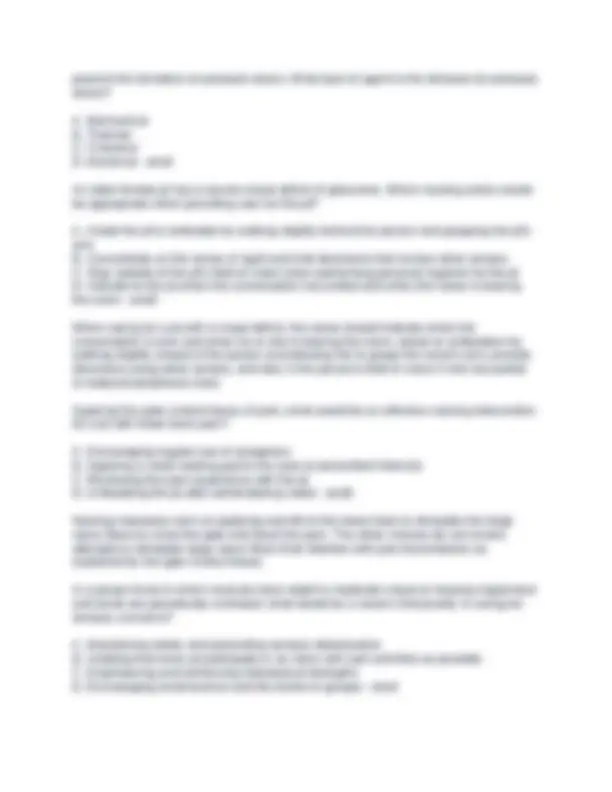
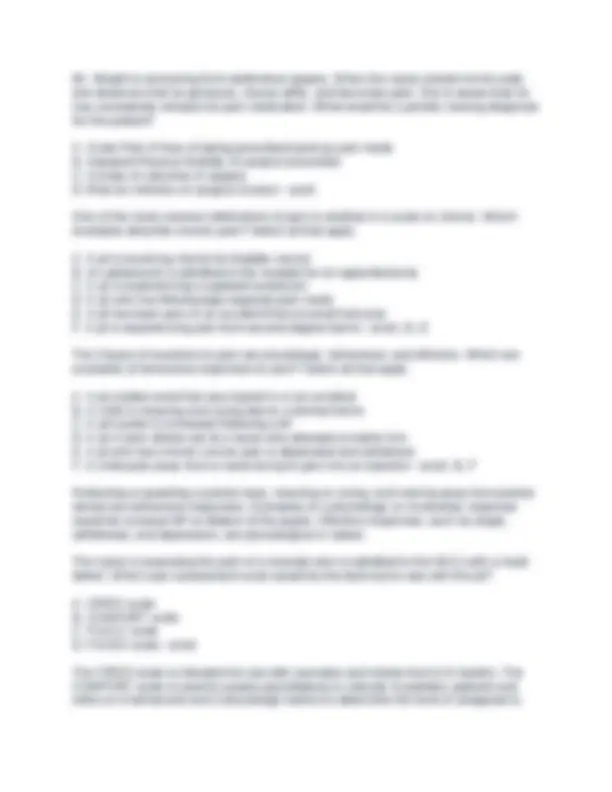


Study with the several resources on Docsity

Earn points by helping other students or get them with a premium plan


Prepare for your exams
Study with the several resources on Docsity

Earn points to download
Earn points by helping other students or get them with a premium plan
Community
Ask the community for help and clear up your study doubts
Discover the best universities in your country according to Docsity users
Free resources
Download our free guides on studying techniques, anxiety management strategies, and thesis advice from Docsity tutors
Nursing assessment scenarios related to pain and sleep disturbances in various patient populations. The scenarios cover different types of pain, nursing interventions to promote sleep, and factors affecting sleep in elderly patients. Students can use this document as study notes, summaries, or schemes and mind maps to understand the concepts of pain and sleep assessment in nursing.
Typology: Exams
1 / 12

This page cannot be seen from the preview
Don't miss anything!







A female pt who is having a MI complains of pain that is situated in her jaw. The nurse documents this as what type of pain? A. Transient pain B. Superficial pain C. Phantom pain D. Referred pain - ansD A nurse asks a pt to close her eyes, state when she feels something, and describe the feeling. The nurse then brushes the pt's skin w/ a cotton ball, and touches the pt's skin w/ both sides of a safety pin. Which sense is the nurse assessing? A. Gustatory B. Olfactory C. Tactile D. Kinesthetic - ansC A nurse assesses a pt's body temp in the late afternoon at 37.2 degrees C (99 degrees F). What would be the nursing action r/t this slight elevation in temp? A. Assess the pt for infection B. Record the temp as a normal finding C. Call the physician for an order for antipyretics D. Decrease the room temp - ansB A nurse caring for pts in a busy hospital environment should implement which recommendation to promote sleep? A. Keep the room light dimmed during the day B. Keep the room cool C. Keep the door of the room open D. Offer a sleep aid medication to pts on a regular basis - ansB A nurse caring for pts in a LT care facility is implementing interventions to help promote sleep in elderly pts. Which action is recommended for these pts? A. Increase physical activities during the day B. Encourage short periods of napping during the day C. Increase fluids during the evening D. Dispense diuretics during the afternoon hours - ansA
A nurse formulated the following nursing diagnosis for an 8-month-old infant: Disturbed Sensory Perception: Sensory Deprivation r/t inadequate parenting. Since that diagnosis was made, both parents have attended parenting classes. However, both parents work while the infant stays w/ her 86yo grandmother, who has reduced vision. The parents provide appropriate stimulation in the evening. At an evaluation conference at the age of 11 months, the infant lies on the floor sucking her thumb and rocking her body. Her facial expression is dull and she vocalizes only in a low monotone. Which statement accurately reflects evaluation about the child's sensory deprivation? A. The infant's parents lack motivation to provide necessary stimulation B. The grandmother is unable to improve the infant's care C. The infant's sensory deprivation is still severe D. This is normal behavior for an 11-month-old infant - ansC A nurse formulates the following diagnosis for an elderly pt who is having trouble getting to sleep at night: Disturbed Sleep Pattern: Initiation of Sleep. Which of the following nursing interventions would the nurse perform r/t this diagnosis? Select all that apply. A. Arrange for assessment for depression and treatment B. Discourage napping during the day C. Decrease fluids during the evening D. Administer diuretics in the morning E. Encourage the pt to engage in some type of physical activity F. Assess medication of side effects of sleep pattern disturbances - ansA, B, E, F For pts who are having trouble initiating sleep, the nurse should arrange for assessment for depression and treatment, discourage napping, promote activity, and assess meds for sleep disturbance side effects. Limiting fluids and administering diuretics in the morning are appropriate interventions for Disturbed Sleep Pattern: Maintaining Sleep. A nurse formulates the following diagnosis for an older female pt in a LT care facility: Disturbed Sensory Perception: Chronic Sensory Deprivation r/t the effects of aging. The pt walked out the door unobserved and was lost for several hours. Which interventions would be most effective for this pt? Select all that apply. A. Ignore when the pt is confused or go along to prevent embarrassment B. Reduce the # and type of stimuli in the pt's room C. Orient the pt to time, place, and person frequently D. Provide daily contact w/ children, community people, and pets E. Decrease background or loud nosies in the environment F. Provide a radio and TV in the pt's room - ansC, D, F A nurse instructor is teaching a class of student nurses about the nature of pain. Which statements accurately describe this phenomenon? Select all that apply.
A nurse is caring for a pt who states he has trouble sleeping ever since his job at a factory changed from the day shift to the night shift. Which diagnosis would be the most appropriate for this pt? A. Ineffective Coping: Multiple Stressors of New Job B. Sleep Deprivation: Difficulty Falling Asleep C. Disturbed Sleep Pattern: Altered Sleep-Wake Pattern D. Risk for Injury: Activity Intolerance/Sleep Deprivation - ansC A nurse is diagnosing an 11yo 6th grade student following a physical assessment. The nurse notes that the student's grades have dropped, she has difficulty completing her work on time, and she frequently rubs her eyes and squints. Her visual acuity on a Snellen's eye chart is 160/20. Which nursing diagnosis would be most important? A. Deficient Knowledge r/t visual impairment B. Ineffective Role Performance (Student) r/t visual impairment C. Disturbed Body Image r/t visual impairment D. Delayed Growth and Development r/t visual impairment - ansB A nurse is discussing w/ an older female pt the factors that affect her sleep. What fact does the nurse teach her? A. Drinking a cup of regular tea at night induces sleep B. Using alcohol moderately promotes a deep sleep C. Aging decreases the amount of REM sleep a person experiences D. Exercising decreases REM and NREM sleep - ansC A nurse is performing a sleep assessment on a pt being treated for a sleep disorder. During the assessment, the pt falls asleep in the middle of a conversation. The nurse would expect which disorder? A. REM behavior disorder B. Narcolepsy C. Enuresis D. Sleep apnea - ansB A nurse is providing discharge teaching for pts regarding their meds. For which pts would the nurse recommend actions to promote sleep? Select all that apply. A. A pt who is taking iron supplements for anemia B. A pt w/ Parkinson disease who is taking dopamine C. An elderly pt taking diuretics for CHF D. A pt who is taking antibiotics for an ear infection E. A pt who is prescribed antidepressants F. A pt who is taking low-dose aspirin prophylacically - ansB, C, E
Drugs that decrease REM sleep include barbiturates, amphetamines, and antidepressants. Diuretics, antiparkinsonian drugs, some antidepressants and hypertensives, steroids, decongestants, caffeine, and asthma medications are seen as additional common causes of sleep problems. A nurse is teaching a pt w/ a sleep disorder how to keep a sleep diary. Which data would the nurse have the pt document? Select all that apply. A. Daily mental activities B. Daily physical activities C. Morning and evening body temperature D. Daily measurement of fluid intake and output E. Presence of anxiety or worries affecting sleep F. Morning and evening BP readings - ansA, B, E A sleep diary includes mental and physical activities performed during the day and the presence of any anxiety or worries the pt may be experiencing that affect sleep. A record of fluid intake and output, body temp, and BP is not usually kept in a sleep diary. A nurse observes a slight increase in a pt's vital signs while he is sleeping during the night. According to the pt's stage of sleep, the nurse expects what conditions to be true? Select all that apply. A. He is aware of his surroundings at this point B. He is in delta sleep at this time C. It would be most difficult to awaken him at this time D. This is most likely an NREM stage E. This stage constitutes around 20% to 25% of total sleep F. The muscles are relaxed in this stage - ansC, E This scenario describes REM sleep. During REM sleep, it is difficult to arouse the person, and the vital signs increase. REM sleep constitutes 20-25% of sleep. In stage I NREM sleep, the person is somewhat aware of surroundings. Delta sleep is NREM stages III and IV. In stage IV NREM sleep, the muscles are relaxed, whereas small muscle twitching may occur in REM sleep. A nurse observes some involuntary muscle jerking in a sleeping pt. The nurse determines that the pt is most likely in which stage of sleep? A. Stage I NREM sleep B. Stage II NREM sleep C. Stage IV NREM sleep D. REM sleep - ansA
By the age of 5 years, most children no longer nap. Sleep needs usually increase when physical growth peaks. A nurse working the night shift in a peds unit observes a 10yo male pt walking the hallway in a sleep state. The child is unaware of his environment and doesn't recall the incident in the morning. Which sleep disorder would the nurse expect? A. Bruxism B. Cataplexy C. Restless leg syndrome D. Somnambulism - ansD A pregnant woman is receiving an epidural analgesic prior to delivery. The nurse provides vigilant monitoring of this patient to prevent the occurrence of: A. Pruritus B. Urinary retention C. Vomiting D. Respiratory Depression - ansD Too much of an opioid drug given by way of an epidural catheter or a displaced catheter may result in the occurrence of respiratory depression A pt complains of abdominal pain that is difficult to localize. The nurse documents this as which type of pain? A. Cutaneous B. Visceral C. Superficial D. Somatic - ansB Visceral - poorly localized and can originate in body organs in the abdomen Cutaneous/superficial - involves the skin or subQ tissue (e.g. paper cut) Somatic pain - deep, diffuse or scattered, originates in tendons, ligaments, bones, blood vessels, and nerves (e.g. strong pressure on bone or damage to tissue that occurs with sprain) A pt in an intensive care burn unit for 1 week is in pain much of the time and has his face and both arms heavily bandaged. His wife visits every evening for 15 minutes at 6, 7, and 8 PM. A heart monitor beeps for a pt on one side, and another pt moans frequently. Assessment would suggest that the pt probably is experiencing: A. Sufficient sensory stimulation B. Deficient sensory stimulation C. Excessive sensory stimulation D. Both sensory deprivation and overload - ansD
The pt's bandages may result in deficient sensory stimulation and the monitors and other sounds in the intensive care burn unit may cause a sensory overload. A pt is in the late stages of AIDS, which is now affecting his brain as well as other major organ systems. The pt confides to the nurse that he feels terribly alone b/c most of his friends are afraid to visit. The nurse determines that the least likely underlying etiology for his sensory problems would be: A. Stimulation B. Reception C. Transmission-perception-reaction D. Emotional response - ansD Emotional responses are an effect of sensory deprivation, and although they may be occurring w/ this pt, they are not the underlying etiology for his condition. This pt is receiving decreased environmental stimuli, is more likely experiencing problems w/ reception b/c of major organ involvement, and his impaired brain function will impair impulse transmission-perception-reaction. A pt is post op following an emergency c-section birth. The pt asks the nurse about the use of pain meds following surgery. What would be a correct response by the nurse? A. "It's not a good idea to ask for pain meds regularly, as it can be addictive." B. "It is better to wait until pain gets unbearable before asking for pain meds" C. "It's natural to have to put up with pain after surgery and it will lessen in intensity in a few days." D. Your doctor has ordered pain meds for you, which you should not be afraid to request any time you have pain." - ansD A pt's spinal cord was severed, and he is paralyzed from the waist down. When obtaining data about this pt, which component of the sensory experience would be most important for the nurse to assess? A. Transmission of tactile stimuli B. Adequate stimulation in the environment C. Reception of visual and auditory stimuli D. General orientation and ability to follow commands - ansA Below-the-waist paralysis makes the transmission of tactile stimuli a problem. Although the other options may be assessed, they are indirectly r/t his paralysis and of lesser importance at this time. An elderly pt is confined to bedrest following cervical spine surgery to treat nerve pinching. The nurse is vigilant about turning the pt and assessing the pt regularly to
Mr. Wright is recovering from abdominal surgery. When the nurse assists him to walk, she observes that he grimaces, moves stiffly, and becomes pale. She is aware that he has consistently refused his pain medication. What would be a priority nursing diagnosis for this patient? A. Acute Pain r/t fear of taking prescribed post-op pain meds B. Impaired Physical Mobility r/t surgical procedure C. Anxiety r/t outcome of surgery D. Risk for Infection r/t surgical incision - ansA One of the most common distinctions of pain is whether it is acute or chronic. Which examples describe chronic pain? Select all that apply. A. A pt is receiving chemo for bladder cancer B. An adolescent is admitted to the hospital for an appendectomy C. A pt is experiencing a ruptured aneurysm D. A pt who has fibromyalgia requests pain meds E. A pt has back pain r/t an accident that occurred last year F. A pt is experiencing pain from second degree burns - ansA, D, E The 3 types of reactions to pain are physiologic, behavioral, and affective. Which are examples of behavioral responses to pain? Select all that apply. A. A pt cradles wrist that was injured in a car accident B. A child is moaning and crying due to a stomachache C. A pt's pulse is increased following a MI D. A pt in pain strikes out at a nurse who attempts to bathe him E. A pt who has chronic cancer pain is depressed and withdrawn F. A child pulls away from a nurse trying to give him an injection - ansA, B, F Protecting or guarding a painful area, moaning or crying, and moving away from painful stimuli are behavioral responses. Examples of a physiologic or involuntary response would be increase BP or dilation of the pupils. Affective responses, such as anger, withdrawal, and depression, are physiological in nature. The nurse is assessing the pain of a neonate who is admitted to the NICU with a heart defect. Which pain assessment scale would be the best tool to use with this pt? A. CRIES scale B. COMFORT scale C. FLACC scale D. FACES scale - ansA The CRIES scale is intended for use with neonates and infants from 0-6 months. The COMFORT scale is used to assess pain/distress in critically ill pediatric patients and relies on 6 behavioral and 2 physiologic factors to determine the level of analgesia to
adequately relieve the pain of these children. The FLACC scale (F-faces, L-legs, A- activity, C-cry, C-consolability) was designed for infants and children from age 2 mo to 7 yrs who are unable to validate the presence or severity of pain. The FACES scale is used for children who can compare their pain to faces depicted on the scale. To promote sleep in a pt, a nurse suggests what intervention? A. Follow the usual bedtime routine if possible B. Drink 2-3 glasses of water at bedtime C. Have a large snack at bedtime D. Take a sedative-hypnotic every night at bedtime - ansA When assessing a pt receiving a continuous opioid infusion, the nurse immediately notifies the physician when the patient has: A. A respiratory rate of 10/min with normal depth B. A sedation level of 4 C. Mild confusion D. Reported constipation - ansB Sedation level is more indicative of respiratory depression b/c a drop in level usually precedes it. A sedation level of 4 calls for immediate action b/c the pt has minimal or no response to stimuli. A respiratory level of 10 w/ normal depth of breathing is usually not cause for alarm. Mild confusion may be evident with the initial dose and then disappear. Additional observation is necessary. Constipation should be reported to the physician, but is not the priority in this situaiton. When assessing pain in a child, the nurse needs to be aware of what considerations? A. Immature neurologic development results in reduced sensation of pain. B. Inadequate or inconsistent relief of pain is widespread C. Reliable assessment tools are currently unavailable D. Narcotic analgesic use should be avoided - ansB HC personnel are only now becoming aware of pain relief as a priority for children in pain. The evidence supports the fact that children do indeed feel pain and reliable assessment tools are available specifically for use with children. Opioid analgesics may be safely used with children as long as they are carefully monitored. When developing a PoC for a pt w/ chronic pain, the nurse plans interventions based on the knowledge that chronic pain is most effectively relieved when analgesics are administered in what manner? A. PRN B. Conservatively C. Around the clock (ATC) D. Intramuscularly - ansC